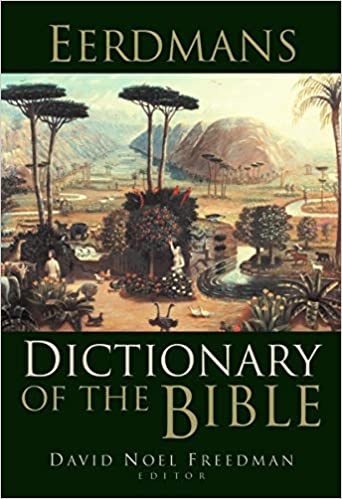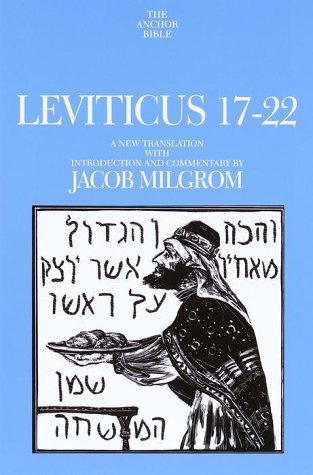Last week we studied the stories of Sodom and Gomorrah, and Gibeah to understand what ancient hospitality required. People who want to criticize, humiliate, demean, or scare the LGBT communities about being gay often use that passage and the two from Leviticus that I’ll address today.
![]() Talking Point Tidbit #1. God’s blessings of land and procreation went hand in hand. God first rewarded the Israelites with their own land. However, God then mandated that Israel had to follow various laws and rituals to remain in good relationship with God. The Israelites had to refrain from conduct that either resulted in illegitimate children, or no children at all. By having illegitimate children from illicit sexual relations, like Lot with his daughters, Israel thereby polluted its prized land. By committing “sexual violations,” God’s penalty culminated in being ejected from the land, or “being vomited up from the land” (Milgrom 1567). We’ll come back to this in a bit.
Talking Point Tidbit #1. God’s blessings of land and procreation went hand in hand. God first rewarded the Israelites with their own land. However, God then mandated that Israel had to follow various laws and rituals to remain in good relationship with God. The Israelites had to refrain from conduct that either resulted in illegitimate children, or no children at all. By having illegitimate children from illicit sexual relations, like Lot with his daughters, Israel thereby polluted its prized land. By committing “sexual violations,” God’s penalty culminated in being ejected from the land, or “being vomited up from the land” (Milgrom 1567). We’ll come back to this in a bit.
The Torah, also known as the Pentateuch
Leviticus appears third in the Five Books of Moses, also known as the Torah, or the Pentateuch. Leviticus serves as a priests’ manual for the Israelite cultic practices. I’m not referring to Israel as a “cult” with all of the negative stereotypes that we would likely assume today. By “cult,” I refer to the various rituals and practices that distinguished the Israelites from those of neighboring nations.
Here are some examples of types of conduct regulated in Leviticus:
- The manner in which animals were sacrificed for thanksgiving and atonement
- The means of atonement for individual and for communal sin
- Care of curable skin diseases
- The annual cycle of daily, sabbath, and festival rituals
- Regulating the purification of women after menses and childbirth
- Regulating the purification of men after seminal emission
- Regulating the purification of anyone coming in contact with a corpse
- Prohibiting sexual relations with close kin
- Prohibiting child sacrifice
- Prohibiting a man having sex with another man
- Prohibiting anyone having sex with an animal
This is not a comprehensive list, but you get the idea. The bolded prohibitions involve fertility, killing children or progeny, or wasting semen with other men and animals. A long list of prohibited sexual relations appear at the beginning chapter 18 (you can view the list via this link).
The Land of Canaan
First, God promised land to Israel. So Moses led Israel from Egyptian slavery and wandering in the desert to that Promised Land, Canaan. Then God intervened and displaced the Canaanites from their land. Obviously, this created tension between Israel and the remaining Canaanites. However, the two nations interacted with each other.
![]() Talking Point Tidbit #2. Because the Israelites had been nomads, they survived on the by-products of their herds–milk and cheese. They knew animal husbandry, but they did not know how to grow their food. They probably turned to the Canaanites for guidance in horticulture. Naturally, they learned of other Canaanite customs regarding daily life including their cultic practices. Israel likely borrowed Canaanite fertility temple rituals so the crops would grow better. Scholars believe the Canaanites practiced temple prostitution with both men and women. This led to conflict with God’s Levitical purity. God wanted Israel, as the chosen people, to distinguish itself from pagan nations and their behavior. The Old Testament establishes a negative view of the Canaanites, especially regarding their religious practices.
Talking Point Tidbit #2. Because the Israelites had been nomads, they survived on the by-products of their herds–milk and cheese. They knew animal husbandry, but they did not know how to grow their food. They probably turned to the Canaanites for guidance in horticulture. Naturally, they learned of other Canaanite customs regarding daily life including their cultic practices. Israel likely borrowed Canaanite fertility temple rituals so the crops would grow better. Scholars believe the Canaanites practiced temple prostitution with both men and women. This led to conflict with God’s Levitical purity. God wanted Israel, as the chosen people, to distinguish itself from pagan nations and their behavior. The Old Testament establishes a negative view of the Canaanites, especially regarding their religious practices.
Keep in mind too, that Israel was a small nation surrounded by pagan cultures. It needed to produce a lot of male children to populate an army, and that fact would have been on everyone’s minds.
![]() Talking Point Tidbit #3. We will first look at the two verses in a standalone fashion, and later we will add in the verses surrounding them to add more context. We add these verses to look at what is happening in the sections before and after a text to be sure we understand what factors influence the primary text, and what later occurs. This process enables us to understand the context of a given passage. If we only zero in on one verse, we run the risk of reading the text with a pretext, a foregone conclusion. Pretext can also involve concealing an intent to mislead understanding or interpretation. A form of pretext concerns offering an interpretation while concealing a preconceived motive or agenda, like condemning all homosexual relationships across time. That condemnation is much easier if the reader only examines v. 22. If you were to read that A killed B without any other information, you would not know if the killing was in self-defense or defense of a third party. You would need more information to draw a proper conclusion. The same is true when assessing biblical context.
Talking Point Tidbit #3. We will first look at the two verses in a standalone fashion, and later we will add in the verses surrounding them to add more context. We add these verses to look at what is happening in the sections before and after a text to be sure we understand what factors influence the primary text, and what later occurs. This process enables us to understand the context of a given passage. If we only zero in on one verse, we run the risk of reading the text with a pretext, a foregone conclusion. Pretext can also involve concealing an intent to mislead understanding or interpretation. A form of pretext concerns offering an interpretation while concealing a preconceived motive or agenda, like condemning all homosexual relationships across time. That condemnation is much easier if the reader only examines v. 22. If you were to read that A killed B without any other information, you would not know if the killing was in self-defense or defense of a third party. You would need more information to draw a proper conclusion. The same is true when assessing biblical context.
__________
Leviticus 18:22 (2 different translations are provided for each verse)
You shall not lie with a male as with a woman; it is an abomination. (RSV translation)
You shall not sleep with a male as one sleeps with a female; it is an abomination.
(NASB translation)
Leviticus 20:13 (This verse adds the punishment of death)
If a man lies with a male as with a woman, both of them have committed an abomination; they shall be put to death, their blood is upon them. (RSV translation)
If there is a man who sleeps with a male as those who sleep with a woman, both of them have committed a detestable act; they must be put to death. They have brought their own deaths upon themselves. (NASB translation) (Italics not mine)
________________
![]() Talking Point Tidbit #4. Most biblical scholars date the writing of Leviticus to the 5th century BCE after King Nebuchadnezzar II defeated Israel. He exiled most Israelites to Babylon. Scholars view Leviticus as an explanation about why Israel was exiled and lost its beloved land. Israel’s inability to live by its holiness code caused Israel’s exile, that is being “vomited from the land.”
Talking Point Tidbit #4. Most biblical scholars date the writing of Leviticus to the 5th century BCE after King Nebuchadnezzar II defeated Israel. He exiled most Israelites to Babylon. Scholars view Leviticus as an explanation about why Israel was exiled and lost its beloved land. Israel’s inability to live by its holiness code caused Israel’s exile, that is being “vomited from the land.”
Let’s look at the verses that come right after v. 22 and 23 — Lev. 18:24-30:
24 “Do not defile yourselves by any of these things, for by all these the nations I am casting out before you defiled themselves; 25 and the land became defiled, so that I punished its iniquity, and the land vomited out its inhabitants. 26 But you shall keep my statutes and my ordinances and do none of these abominations, either the native or the stranger who sojourns among you 27 (for all of these abominations the men of the land did, who were before you, so that the land became defiled); 28 lest the land vomit you out, when you defile it, as it vomited out the nation that was before you. 29 For whoever shall do any of these abominations, the persons that do them shall be cut off from among their people. 30 So keep my charge never to practice any of these abominable customs which were practiced before you, and never to defile yourselves by them: I am the Lord your God.” (RSV) (emphasis mine)
This passage contains several important lessons for Israel. First, note the mandatory language of “you shall.” These instructions were non-negotiable. The big list of no-no’s that occur at the beginning of Leviticus 18 reflects the bad conduct by Israel’s neighbors. As a matter of fact, v. 28 refers to the Canaanites, the nation that had been vomited out to make way for Israel. Defilement can be caused by sexual violations. “I am the Lord your God,” refers to this divine relationship with contractual requirements to be done by both parties, God and Israel. This is a sacred understanding.
Now let’s add in verses that go with our two primary passages.
Leviticus 18:21-24
21 You shall not give any of your children to devote them by fire to Molech, and so profane the name of your God: I am the Lord. 22 You shall not lie with a male as with a woman; it is an abomination. 23 And you shall not lie with any beast and defile yourself with it, neither shall any woman give herself to a beast to lie with it: it is perversion.
This passage prohibits:
- Child sacrifice
- Male to male conduct
- Having sex with animals
Scholars understand that Molech was a Canaanite netherworld god of human sacrifice (Eerdmans 912-13). Child sacrifice and bestiality defeated fertility, either by killing progeny or by engaging in conduct that would not result in child-bearing. These practices appear in a list along with male to male sex because those acts also fail to produce children and waste semen, whether part of ritual prostitution or not. This specific list carves out cultic practices and behaviors that reject Canaanite conduct. It is very likely not an accident that they are clustered together like this. Semen was considered a life force and finite, and the Israelite society viewed its waste as unacceptable.
The grammar and phraseology in both sections also make it unclear whose conduct is condemned, the penetrator or the receiver, or both (Hollenback, 537). Hollenback gives a thorough discussion about the split in authority here, and consequently, one cannot draw a concrete conclusion.
Also notice that the word “homosexuality” does not appear here because that term was unknown. It certainly would not have meant what we understand it to mean today — a sexual orientation where men are attracted to other men and the majority engage in lifetime partnerships, and now same-sex marriages.
While these verses have served as primary weapons against LGBT people, clearly our modern-day understanding of long-lasting bonds between two men or two women could not have been contemplated and thus included in these prohibitions.
Leviticus provides instructions on how Israel could distinguish itself from surrounding nations by strictly proscribing sexual conduct and temple prostitution, amongst other things. We must respect the context of Israel living in the land of Canaan and what that required of them.
Likewise, we must recognize our 21st century context that understands what sexual orientation is and how same-sex couples bond as strongly as heterosexual couples do, and they form loving, lifelong partnerships and even raise children together.
Blessings on your journey.+
A Note of thanks goes to Astrid B. Beck, Ph.D.!
Dr. Beck sat on my doctoral committee, and she is a dear friend. I consulted with Dr. Beck on this blog because she is a widely respected biblical scholar and was the managing editor of various Anchor Bible Series. Many thanks, Dr. Beck! It is important to me to offer the best information available to aid in studying the Bible. I’ve included a few resources here that support this blog.
 Freedman, David Noel, ed. Allen C. Myers, Assoc. Ed. Astrid B. Beck, Managing Ed. Eerdmans Dictionary of the Bible, Eerdmans: Grand Rapids, 2000.
Freedman, David Noel, ed. Allen C. Myers, Assoc. Ed. Astrid B. Beck, Managing Ed. Eerdmans Dictionary of the Bible, Eerdmans: Grand Rapids, 2000.
The Eerdmans Dictionary of the Bible gathers nearly 5,000 alphabetically ordered articles that thoroughly yet clearly explain all the books, persons, places, and significant terms found in the Bible. The Dictionary also explores the background of each biblical book and related writings and discusses cultural, natural, geographical, and literary phenomena–matters that Bible students at all levels may encounter in reading or discussion.
George M. Hollenback, “Who is Doing What to Whom Revisited: Another Look at Leviticus 18:22 and 20:13,” The Journal of Biblical Literature, vol. 136, no. 3 (2017): 529-537.
 Jacob Milgrom, Leviticus 17-22: A New Translation with Introduction and Commentary, The Anchor Bible Series, Yale University Press, v. 2 of 3, 2000.
Jacob Milgrom, Leviticus 17-22: A New Translation with Introduction and Commentary, The Anchor Bible Series, Yale University Press, v. 2 of 3, 2000.





